Japan
Wood Products Prices
Dollar Exchange Rates of 10th
Jun
2022
Japan Yen 134.37
Reports From Japan
Plan for a ¡®new form of
capitalism¡¯
The Cabinet has approved plans for what the government
calls "a new form of capitalism." One of the cornerstones
of the plan will be strategies aimed at raising wealth
through investment of the huge savings held by Japanese.
At the same time there will be a focus on climate change
and digital transformation. The plan also calls for a big
increase in spending in science, technology and innovation
along with a public/private sector effort to increase the
number of business startups.
On the environment the government will work with the
private sector to invest about 100 trillion yen over the next
10 years to reduce Japan's carbon emissions.
See:
https://www3.nhk.or.jp/nhkworld/en/news/20220607_35/
Supply shortages and rising prices hit manufacturers
Russia¡¯s invasion of Ukraine and sanctions by many
countries has disrupted energy and raw material supplies
causing prices to rise.
A survey of companies nationwide conducted by Teikoku
Databank from mid-to-late April focused on the impact of
sanctions and Russia¡¯s export bans on raw materials.
Among the companies that responded to the survey 51%
say they have been affected in terms of securing necessary
supplies and most said they are affected by price increase.
The ban on wood product exports by Russia has led to
what has been described in Japan as a ¡°wood shock¡± and is
seriously affecting the construction sector.
For the survey results see:
https://www.nippon.com/en/japandata/h01333/
No more mention of pandemic impact on economic
prospects
Confidence among workers with jobs sensitive to
economic trends rose for the third straight month in May
on the back of the removal of anti-coronavirus restrictions.
The Cabinet Office upgraded its basic assessment of
economc prospects saying, "The economy is gradually
picking up". For the first time since February 2020 the
government statement dropped its reference to the
negative impact of the pandemic.
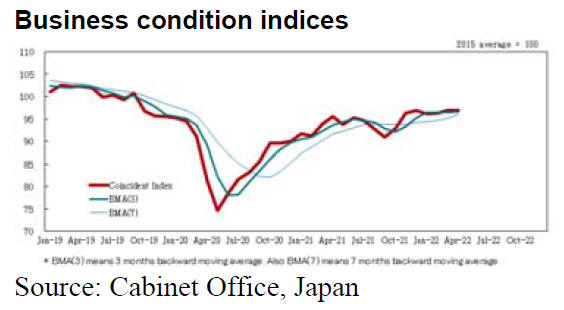
Emergency budget to help households
Soaring prices for consumer goods are hurting households
with prices for basics increasing and this is driving down
consumer spending. The government has drafted a
supplementary emergency budget designed to ease the
burden on households and it includes subsidies for petrol
wholesalers along with cash payouts to low-income
households with children.
In April, for the first time in seven years, consumer
inflation in Japan exceeded 2%, higher than the Bank of
Japan (BoJ) target and this will likely remain for a while.
The BoJ has indicated it will maintain the monetary easing
measures on the assumption that consumer price increases
are temporary and that the economy is not resilient enough
to endure fiscal tightening.
See:
https://www3.nhk.or.jp/nhkworld/en/news/backstories/2012/
Spending during spring holidays good news for the
economy
After plummeting in the first three months of this year to
levels not seen for a long time, the consumer confidence
index flattened in April and showed a modest uptick in
May. The rise coincides with the lifting on covid control
measures which allowed people to travel and spend during
the May holidays.
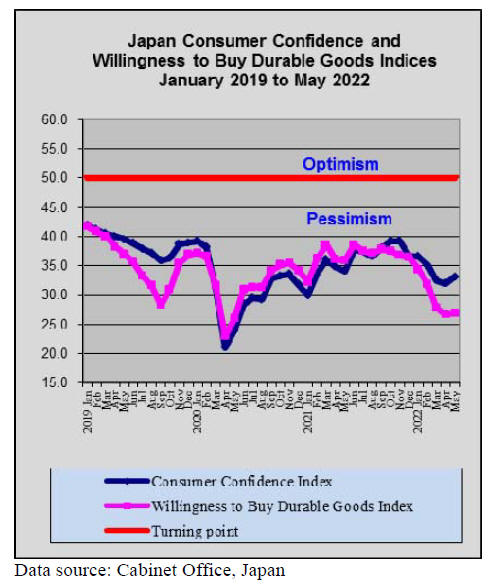
Higher consumer prices inevitable
Wholesale price inflation accelerated in May to 9% from a
year earlier reflecting higher raw material prices and sharp
declines in the yen that pushed up the cost of imports.
Prices for goods traded between companies rose further
marking 15 consecutive monthly of increases. This raises
the prospect of higher consumer prices that will dent
private consumption.
Profitability a major issue for house builders
The 2021 finacial reports by major house builders show
that orders in 2021 exceeded those in 2020 when the
covid infection rates and lockdowns were at a peak.
However, the Japan Lumber Reports says orders placed
with builders started to decline in the second half of fiscal
2021.
Profitability has become a major issue for house builders
because of the high and steadily rising costs of wood
products and other building materials. Builders anticipate
a tough year for profits in 2022.

Danger that the yen could tilt to 150 to the
dollar
At one point in early June the yen weakened to 135 against
the US dollar, just short of the low seen in 2020, a slide
that threatens to turn into an economic and financial
headache for many financial markets.
Analysts write ¡°the danger is that the yen could tilt to 150
to the US dollar at which point intervention would likely
be the response or it could be that other Asian countries
would devalue their currencies to maintain export
competitiveness¡±.
See:
https://www.japantimes.co.jp/news/2022/06/09/business/economy-business/yen-drops-further/
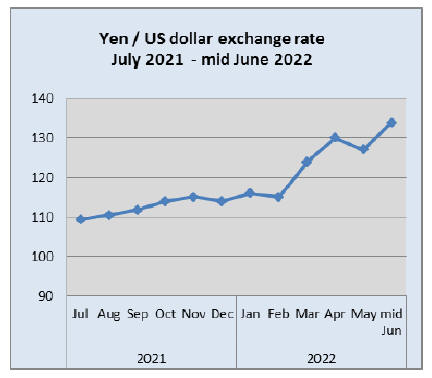
Furniture imports
First quarter imports
Despite the pandemic, collapsed consumer confidence and
the disruption of the timber sector because of the Russian
invasion of Ukraine, imports of wooden bedroom furniture
just keep rising in contrast to the value of imports of
wooden office and wooden kitchen furniture which have
remained at around the same level as in the first quarter of
the past four years.
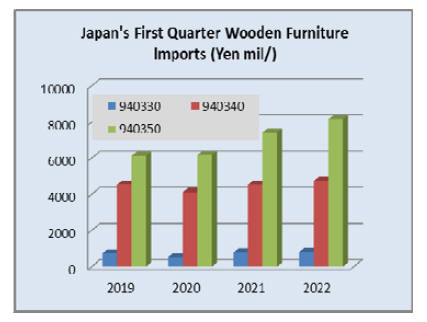
March office furniture imports (HS 940330)
February saw a correction in the value of wooden office
furniture imports but that was reversed in March bringing
the value of imports back up to the average for the year.
Year on year the value of March imports of wooden office
furniture (HS940330) declined by around 18%. The
downward trend in the yen dollar exchange rate and the
subdued business sentiment were the major factor behind
the decline.
As in previous months the top shipper of wooden office
furniture in March 2022 was China accounting for 85% of
total wooden furniture imports. The only other shippers of
note I March were Italy and Poland and the value of their
combined shipments in March was just less than 7% of all
March arrivals.
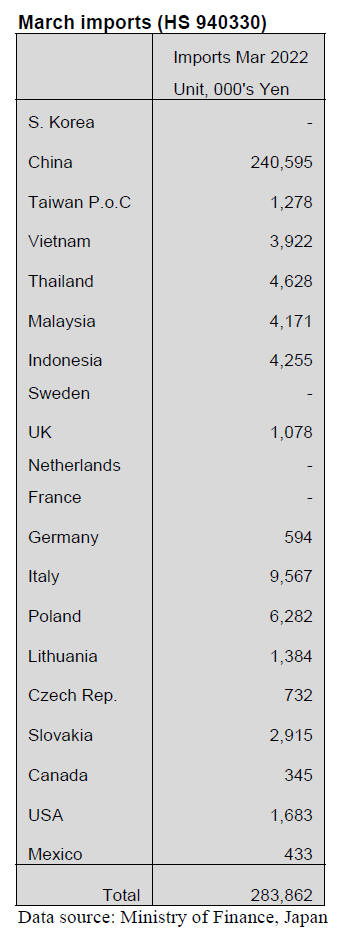
March kitchen furniture imports (HS 940340)
The value of Japan¡¯s March imports of wooden kitchen
furniture was up around 10% from February and added to
the upward trend noted in February.
There were two major shippers of wooden kitchen
furniture in March, the Philippines and Vietnam and
manufacturers in these two countries have a commanding
position in imports of wooden kitchen furniture.
The value of shipments from the Philippines little changed
from February but accounted for just under 50% of all
wooden kitchen furniture imports in March. Shipments
from Vietnam accounted for around 30% of wooden
kitchen furniture imports and were up about 15% from
February.
China was the third ranked shipper of wooden kitchen
furniture in March but accounted for around 6% of the
value of total March arrivals.
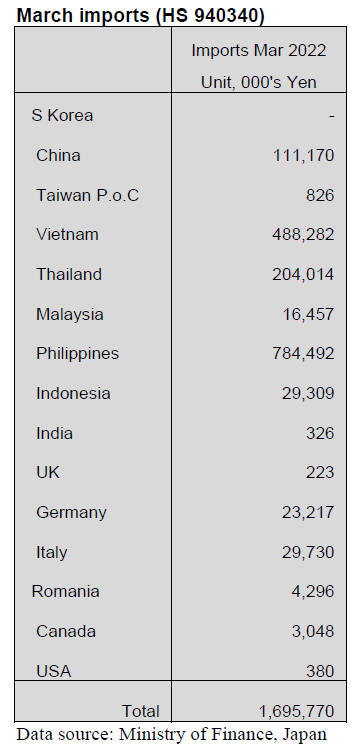
March bedroom furniture imports (HS 940350)
After three months of increases since January this year
there was a correction in February and March data shows
there was a modest increase in the value of imports in
March.
China remained the main supplier of wooden bedroom
furniture to Japan in March accounting for 56% of the
value of imports of HS 940350. The second ranked
shipper in terms of import value was Vietnam at 33%,
slight less than a month earlier.
Shippers in Malaysia did well in March lifting ther value
of shipments to around 5% of total arrivals, up from the
3% in February. Year on year, March 2022 imports were
some 20% higher than a month earlier but were flat month
on month.
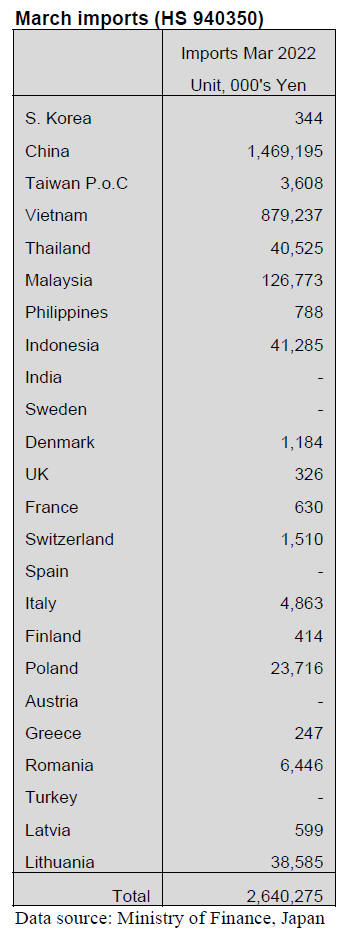
Correction
In our previous report it was stated that Japan had banned
imports of sawnwood from Russia, this was incorrect. The
Japanese government has banned log, wood chips and
veneer imports from Russia.
Trade news from the Japan Lumber Reports (JLR)
The Japan Lumber Reports (JLR), a subscription trade
journal published every two weeks in English, is
generously allowing the ITTO Tropical Timber Market
Report to reproduce news on the Japanese market
precisely as it appears in the JLR.
For the JLR report please see:
https://jfpj.jp/japan_lumber_reports/
A price hike of softwood plywood
Major plywood companies in Eastern Japan raised the
prices of structural softwood plywood in June. The price
of 3 x 6 of 12mm is now 2,000 yen per sheet delivered,
which is 100 yen up from last month. Major plywood
companies in Western Japan also announced about a price
hike to the customers.
Since the prices of logs, glue and freight
increased, the
prices of softwood plywood climbed for straight 15
months. The bottom prices doubled or more and nearly
1,100 yen increase in total and it is 100,000 yen for per
cbm.
Prices of 3 x 6 24mm is 4,000 yen per sheet delivered and
it is 200 yen higher than before. Price of 3 x 6 of 28mm is
4,700 yen per sheet delivered and it is 250 yen higher than
last month. The prices of long plywood will increase but
not sure for how much would be. The prices of plywood
for floor will depend on each customer.
There is active demand for plywood and not enough
supply due to a big holiday at the end of April through
May. Some plywood companies had holiday a week
earlier because of machine maintenance. Some other
plywood companies put priority of supply for precutting
companies which had ordered directly to the plywood
companies.
The supply of cedar logs has been settled down but larch
and Douglas fir logs are still not enough supply. The
prices of domestic logs are still high and the prices of
imported Douglas fir logs are soaring. The influence of
banned importing Russian veneer will surface as an issue
in June. Even if working days become longer, there will be
reduced production.
It will be difficult to keep same production even though
using logs instead of veneers because there are a lot of
process to produce veneers from logs. On the other hand,
the volume of imported softwood plywood from China
keeps growing. It is concerned about a balance between
supply and demand. The prices are higher than the
domestic softwood plywood but the demand continues.
This situation might cause a relaxation of supply and
demand.
If the prices of 3 x 6 of 12mm reach to 2,000 yen per sheet
delivered then the price hike will calm down by several
plywood manufacturing companies. However, the prices
of logs are unsure in the future. Situation is unpredictable
because there are the price hike of freight charges and
glue.
A rise in price of imported plywood
The prices of 3 x 6 of coated plywood for concrete
forming at the Greater Tokyo Metropolitan area are 2,200
yen per sheet delivered. It is 200 yen higher than last
month. The reasons are that a price hike of plywood in
South Asia by the suppliers and a weak yen. The prices of
plywood have also skyrocketed. The structural South Sea
hardwood plywood has been used as substitution for
structural domestic softwood plywood. The prices are
2,100 yen per sheet delivered and it is 100 yen more than
last month.
Some construction firms were anxious about a sign of
rising prices and a lack of supply at the end of April so
they rushed to buy the product. The future prices are
2,300 yen on FOB truck per sheet.
This price hike is caused by structural plywood. There
will be a tight supply from Malaysia because there are still
not enough logs. Some Malaysian plywood companies
had to stop an operation due to a shortage of logs. It is the
best season to harvest the trees in April to June as usual,
but in this year log supply continues tight.
The export prices of 3 x 6 of coated plywood for concrete
forming are US$840 - 850, C&F per cbm. It is US$10
more than last month and new contracts are getting less. It
is hard to order specific plywood because there is limited
amount of producing plywood. Some distribution
companies hesitate to sign up new contracts because there
were fewer orders in Japan. There will be a big and serious
problem of a lack of coated plywood for concrete forming
if this situation continues.
Price increase of Vietnamese plywood
Market prices of Vietnamese plywood for crating in
Tokyo are climbing. Particularly lower grade prices. They
are up from May by 1,000 yen on 8.5 mm thick 4x8 per
sheet delivered. Main reason of price increase is recent
depreciation of the yen, which pushes the Yen cost
higher.
The February rate was about 115 yen per dollar then in
March it shot up to 120 yen so the products imported after
April are influenced by fluctuation of the yen rate. The
inventory has been dropping since last April so that the
dealers placed more orders to the suppliers. Production
and transportation cost is climbing with higher adhesive
cost by higher oil prices then container freight remains
high without any sign of softening.
Plywood
Softwood plywood production in last April exceeded the
shipment so the inventory increased over 100 M cbms
after a year but the shipment continues busy so that this is
temporary lull. Plywood manufacturers continue a full
production but it is hard to increase further because of
difficulty of having enough material logs and workers.
Large house builders are cautious about future demand
after house orders are declining but orders by precutting
plants and wholesalers continues active with little
inventory on hand.
Domestic plywood manufacturers raised the sales price of
12 mm thick 3x6 panel to 2,000 yen per sheet because of
higher cost of logs, adhesive and transportation. One
major concern is increasing import of Chinese made
softwood plywood. April supply was over 10,000 cbms
and this could disturb domestic plywood market if large
volume continues coming in.
Market prices of imported hardwood 12 mm panel are
climbing. In Tokyo market, 3x6 concrete forming panel
prices are 2,200 yen per sheet delivered, 200 yen from
May.
Higher export prices and weak yen make arrived cost
high.
Users made hasty purchase since last April and this made
speculative move and the dealers increased the sales
prices.
Imported structural panel prices climbed to follow higher
prices of softwood structural panel and this pulled
concrete forming panel prices up.
In Malaysia, log supply continues very low despite arrival
of dry weather so the supply of hardwood plywood for rest
of this year looks hopeless.
Housing demand ¨C profit margins slide
The closing accounts of 2021 of major house builders for
order made units exceeded the result of 2020. This is
because there were fewer orders due to a COVID-19 in
2020. However, the orders started to decrease at the
second half of the fiscal year of 2021. A profitability of a
house started decreasing slightly because of high-priced
lumber and building materials. This situation has been
continuing in this year. Some builders predict that the
profit will decrease in the 2022 fiscal year.
It was brisk for accepting orders and selling the detached
house for sale in the first half of the fiscal 2021. The
internet was used for promotion of a new style of houses.
A new system of storage of electricity, an airconditioning
system and a room arrangement made
people to buy houses. Some people who were thinking to
buy condos changed their minds to buy detached houses
due to high-priced condos.
The wood shock occurred in April, 2021 and there were
anxious about a shortage of lumber. The prices of lumber
were double compared to the year of 2020. However,
major house builders could avoid a long delay of
construction because they could buy the materials. Then
they made the profit. The demand started decreasing
since last September. One of reasons was that a housing
tax cut had ended. Other reason was that people started to
go outside after a removal of the state of emergency.
A profit of a house started to decrease because of the
wood shock, a lack of plywood and a price hike of
lumber, plywood and other building materials.
Many house builders struggle with accepting new orders
and high-priced materials. It is hard to make profit. A war
in Ukraine by Russia has been influencing a rise in prices
in Japan and people are losing their interests for buying
houses. Several companies will focus on promotion on
the internet.
Many house builders had good closing accounts of 2021
due to the wood shock. The supply of steel, chemical
synthesis materials, fuels, plywood and water heaters
were not enough before but now the inventory of lumber
are too much. It is said that the results will be different on
each type of business and company in this term.
Domestic logs and lumber
There are enough logs in Japan so far. Some logs are still left
in forest because there are too many logs at stock yards.
Usually, there are not enough logs in this season because
people start spending time for afforesting but in this year the
log prices are high so log suppliers keep harvesting trees.
There are enough cedar logs and cypress logs in
inventory, so the prices are falling down slightly. Cedar
logs for lumber are around 16,000 yen per cbm at
markets. There is a possibility that the prices would be
lower because the temperature and humidity make log
quality deteriorating. However, larch is popular as
substitution for Russian lumber. Plywood companies,
crating companies and laminated lumber companies are
struggling to buy larch and pine logs. Battle to buy logs
continue.
Larch logs in the Tohoku Region are 30,000 yen per cbm
at markets. Demand exceeded supply in this area. The
movement of lumber is calming down because move of
Russian or European lumber to domestic lumber had
calmed down. The current prices of KD cedar studs are
90,000 ¨C 100,000 yen of 3 m x 30 x 105 mm and KD
cedar posts are 100,000 ¨C 110,000 yen of 3 m x 105 mm.
|